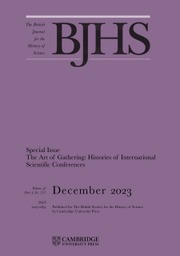Approaching Stephen Case’s second book, Creatures of Reason, through the lens of scientific biography would be a natural impulse, but, I think, a mistaken one. What we have here is the history of an episode in the development of science as a category, a narrative with two central characters. One, familiar from Case’s other work, is Sir John F. W. Herschel (1792–1871), son of William Herschel (1738–1822), discoverer of Uranus, and nephew of Caroline Herschel (1750–1848), one of the most adept analysts of astronomical data of her day. But there is a second main character in this story: the book for which Herschel would be best known in his own day, and which still garners the lion’s share of his fame (especially in the philosophical community): A Preliminary Discourse on the Study of Natural Philosophy (1830). Published in Lardner’s Cabinet Cyclopaedia series, it marked a crucial moment in the scientific formation of a cast of characters, from Charles Darwin, to Michael Faraday, to countless everyday readers who approached the work as something like a crash course in the virtues that should be possessed by any rational, truly scientific thinker.
Case’s book, then, is the story of how Herschel became the person who was capable of writing the Preliminary Discourse. Although, to be sure, this gives it many commonalities with a scientific biography, it only covers the first forty years or so of Herschel’s life, stopping just at Herschel’s voyage to the Cape of Good Hope, prior to his full role in the invention of photography, before his days administering the Royal Mint. Perhaps the book’s most remarkable feature is what it does not have. One might be worried that, in orienting the book entirely toward the yet-to-occur publication of the Preliminary Discourse, Case’s history of Herschel’s life would be too Whiggish, a kind of teleological presentation of the steps that inexorably led to his magnum opus. But it is just here that I found the book particularly impressive. For, as Case clearly demonstrates in this delightfully readable volume, the Preliminary Discourse arose directly from the vast array of experiences which Herschel lived from his earliest days attempting to reform mathematics education at Cambridge. His time studying law (along with the chemistry experiments he would perform on the side), his work in building the Astronomical Society, his constant skirmishes with fellow reform-minded scholars against the slow-moving Royal Society, his several trips across the European continent building a research network (and being exposed to superior forms, he thought, of scientific work and governance), his marriage to the devoutly religious Margaret Brodie Stewart (1810–84), his expansion and eventual completion of his father’s astronomical survey programme – all of these influences can be, Case deftly argues, more or less directly read from the pages of the book that would result from this period of his life. Far from being a teleological supposition, Case’s book demonstrates that the Preliminary Discourse echoes with the life that Herschel had built in his first forty years.
To pull out only two noteworthy threads, the way in which Case fashions a narrative around Herschel’s organizational efforts is impressive. For Herschel, virtues that should be expressed in the life of a particular scientist and those that should be expressed in a community composed of such scientists are one and the same. What unifies these stories – which might otherwise be lost in unconnected histories of personal insult and intrigue – is, for Case, Herschel’s steady construction of his vision of the virtuous scientific enterprise, and, with it, the model for the virtuous scientific life. Worthy also of note is Case’s explication of the role of Herschel’s religious convictions – which changed rapidly from his courtship in 1827 to his marriage in 1829. Herschel’s adoption of a more overt natural-theological position in the Preliminary Discourse can be traced, Case claims, directly back to the tenets of a stable, providentially guided universe (again, with the idea of a stable, religiously grounded family life as the expression of corresponding personal virtue) that he drew from his wife’s deeply religious family.
We will have to wait to see whether Case (or someone else) takes up his challenge to explore the second half of Herschel’s life. But the story told here is one that will be of interest to anyone who hopes to know how the notion of what it meant to do ‘science’ and be a ‘man of science’ changed over the first decades of the nineteenth century. As Case notes, in this period – with Herschel himself serving as an exemplar – we find ourselves with one foot in the older, natural-philosophy tradition and one foot in a concept of science and the scientific life that would be familiar to any contemporary scientist. In Herschel’s own struggles to find his place in this community (ultimately, a place that would be about as central as that of anyone in the United Kingdom during his lifetime), we find a carefully sketched microcosm of the difficulty with which this new scientific world came into being.



